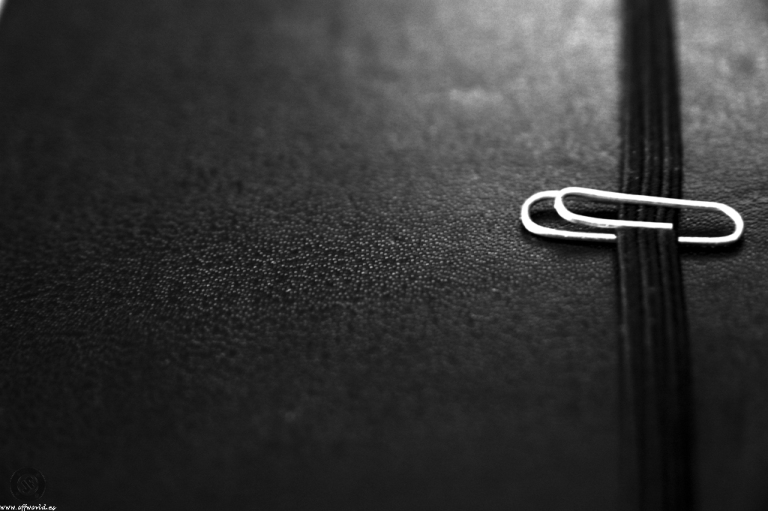 Not long ago, walking past some court buildings with a friend, I kept stopping to pick up paper clips. Besides the usual little Gem clips, like ACCO Brand Trombones No 1, I found a black-and-silver binder clip and a rare angel-shaped “ideal clamp”–all of them no doubt carelessly dropped by lawyers who once used them to hold together reams of paper and their clients’ worst fears. My friend asked what I’d do with these paper clips, what I do with all the paper clips I’ve picked up. “Do you have a big box, or some sort of display?” he said, clearly amused at the thought that I privately worshipped at a bizarre altar festooned with paper clips, like an ancestor shrine. I was offended. “No!” I said. “I use them!”
Not long ago, walking past some court buildings with a friend, I kept stopping to pick up paper clips. Besides the usual little Gem clips, like ACCO Brand Trombones No 1, I found a black-and-silver binder clip and a rare angel-shaped “ideal clamp”–all of them no doubt carelessly dropped by lawyers who once used them to hold together reams of paper and their clients’ worst fears. My friend asked what I’d do with these paper clips, what I do with all the paper clips I’ve picked up. “Do you have a big box, or some sort of display?” he said, clearly amused at the thought that I privately worshipped at a bizarre altar festooned with paper clips, like an ancestor shrine. I was offended. “No!” I said. “I use them!”
The trouble is, once you start seeing paper clips, you can’t stop seeing them. My obsession with lost paper clips started years ago, when I resolved to start gathering coins. I’d read some article that argued that only a fool would walk past free money and that taking a second to collect a coin meant that, at that moment, you’d be making more than minimum wage. I started scanning the ground for nickels, dimes, or quarters, but hardly ever found any. Instead, I saw the metallic flash of paper clips.
Figuring that one paper clip was worth roughly one penny, I started picking them up. This hobby seemed harmless at first, but I should have known myself well enough to foresee my vulnerability. Paper clips in the abstract do not move me—I’ll never read design-oriented books like “The Perfection of the Paper Clip.” What makes me feel weak and tender and deeply sad is the sight of a forgotten paper clip alone in a sidewalk crack.
 Lately, I’ll avert my eyes and ignore its poignant call. But for a long while, I eagerly collected lost paper clips. I’d take the same route to and from work pretty much every day, walking on the same sidewalks over and over again. And, every day, I’d find paper clips. Big and small, rusted and new, plastic-coated and galvanized steel. Once I found a whole pile of brightly colored paper clips under a tree and accused my husband of planting them there, but he swore he hadn’t.
Lately, I’ll avert my eyes and ignore its poignant call. But for a long while, I eagerly collected lost paper clips. I’d take the same route to and from work pretty much every day, walking on the same sidewalks over and over again. And, every day, I’d find paper clips. Big and small, rusted and new, plastic-coated and galvanized steel. Once I found a whole pile of brightly colored paper clips under a tree and accused my husband of planting them there, but he swore he hadn’t.
Someone certainly seemed to be throwing paper clips in my path, and I soon realized that this someone was everyone. An article inThe Wall Street Journal reported that it was unusual that the United States continues to domestically manufacture most of its paper clips, but noted: “a bigger mystery is what Americans do with the estimated 11 billion clips sold annually in the U.S. That works out to about 35 per American.” The article quoted a senior executive at Officemate as saying, “We actually can’t understand how the U.S. consumption can be so huge.”
I can’t understand how they can’t understand; the answer is literally lying at their feet. That article went on to list some of the odd jobs routinely found for paper clips, such as unclogging tubes of glue, hanging Christmas ornaments, cleaning fingernails. What went unmentioned is the most ordinary fate: simply getting lost.
On weekday mornings as I’d walk to work with my hand in my pocket, caressing the curved edges of the paper clip I’d just secreted away, I’d occasionally marvel that this steel was once part of our planet. Sometime, somewhere, strangers harnessed huge machines to rip hunks of iron and carbon out of the inner Earth, probably in the form of coke and iron ore, then blasted them and shaped them and dipped them in molten zinc.
Or, going back even further, billions of years ago these elements were conceived inside stars that lived and died and sent the atoms traveling through space and time to meet me in the form of this thin double curve that looks like a mother curled protectively around a tiny version of herself. My hand curled around them both. The ashes of stars also made my hand, but that’s become a cliché–the fact that I am star dust seems somehow less miraculous than the fact that a paper clip is. This paper clip and I will both inexorably break down and decay. How long will it take a bit of metal wire to rust away? Twenty-five years? Two hundred years? I could find the expert, I am sure, who knows.
Still walking down the sidewalk, tracing this new-but-already-familiar shape with my fingertips, I’d wonder how many people touched this paper clip, in one way or another, before me. I’d imagine miners, factory workers, truck drivers, sales clerks. How many times did this paper clip get lost, and found, then lost and found and lost and found again?
“Find a penny, pick it up, and all day you’ll have good luck.” Find a paper clip, pick it up, and all day you’ll have–a paper clip. The penny retains its arbitrarily-granted value even if it goes unspent, even if it’s collected in a jar with thousands of other pennies and stashed away in a closet for decades. A paper clip, holding no paper, is worth nothing, unless you need one and rummage around to find one and then, for as long as you need it, that paper clip is worth exactly what you need.
Once, after I’d interviewed a psychology researcher, we chatted for a while and he mentioned his studies on why some people have a tendency to anthropomorphize inanimate objects. His answer: loneliness. As one of his papers put it: “A person feeling lonely, isolated, or lacking social connection may attempt to recover from this social pain by anthropomorphizing nonhuman agents—essentially creating social connection by making it up in nonhuman agents.”
The researchers noted, however, that children do this much more than adults, and will “attribute intentions and causal agency widely to the simplest and most abstract of nonhuman stimuli.” Especially, in my house, if that nonhuman stimuli talks in a comically high or low version of my voice. My young son and daughter will, without hesitation, speak with a piece of crud on the kitchen floor and I, without hesitation, will become that piece of crud, or the wax from around a small wheel of cheese, or a random selection from a plate of crudité. “Carrot,” my son said thoughtfully in the middle of a conversation with the vegetable in my hand, after routinely talking with household objects for over half his life, “How can you talk? You don’t have a mouth.” The carrot, taken aback, was momentarily silent.
Headed to the office, waiting on the subway platform, I spy something shining on a hexagonal floor tile. It’s a gold hoop earring. Someone woke up this morning, or perhaps yesterday morning, and yawned and stretched and drank coffee, then ambled over to a bedroom bureau strewn with jewelry and selected this earring, along with its matched pair. Maybe it was a gift from her lover; maybe he is waiting for her downstairs. The woman looks into the mirror and smiles. Later she will reach up and feel that this earring is gone. She will experience a pang of sadness and may even search for this earring, retracing her steps and scanning the ground. I have no desire to bend down and touch this thing—it doesn’t need me.
I can’t remember when I noticed that it caused me physical pain to walk past a paper clip on the sidewalk and just leave it there, when I realized that my amusing pastime had morphed into something less voluntary and that it was time to stop. Maybe it was after I gave birth to my first child. Maybe it was when I finally understood that my paper clip rescues were an illusion, that the paper clips were not safe, and never would be.
 That’s because no one grieves for a paper clip, except for me, although, in truth, no one grieves for a paper clip, not even me. I use them and then, without noticing, I lose them, every single one. Certain individual paper clips linger in my memory. There was the giant Gem clip, as big as my hand, that I saw just after I vowed to stop picking up paper clips. I picked it up. And the two on the floor of a subway car, beneath a seat—I had to make a decision to say, “Excuse me,” and dive underneath the legs of a bewildered passenger, uncomfortably close, to grab them and get out before the door closed. Then there was another day on the subway, when I was alone and gazing at my reflection in the window as the train car rumbled through a dark tunnel. I glanced down and saw, wedged into the rubber seal around the window pane, a solitary Gem clip.
That’s because no one grieves for a paper clip, except for me, although, in truth, no one grieves for a paper clip, not even me. I use them and then, without noticing, I lose them, every single one. Certain individual paper clips linger in my memory. There was the giant Gem clip, as big as my hand, that I saw just after I vowed to stop picking up paper clips. I picked it up. And the two on the floor of a subway car, beneath a seat—I had to make a decision to say, “Excuse me,” and dive underneath the legs of a bewildered passenger, uncomfortably close, to grab them and get out before the door closed. Then there was another day on the subway, when I was alone and gazing at my reflection in the window as the train car rumbled through a dark tunnel. I glanced down and saw, wedged into the rubber seal around the window pane, a solitary Gem clip.
Where is that paper clip now? Where do all the paper clips go? I know and I don’t know. Their whole purpose is to bring together separate pieces that make sense and come to life only when they’re together. And yet, inevitably, the pieces fall apart, they are separate and it is in their nature to come apart, and that means whatever held them together must disappear, it will always disappear, it will disappear again and again and again and, in the end, no one can say where it has gone.
________
Nell Greenfieldboyce reports on science for NPR and loves radio but sometimes misses print. Her last LWON post was about a funnel spider. She rarely tweets at @nell_sci_NPR
___________
Photos by Pablo Fernández, Placbo, JF Sebastian, all via Flickr
“The carrot, taken aback, was momentarily silent”: this might be the best sentence I’ve read in a while.